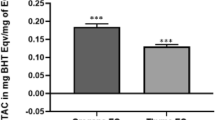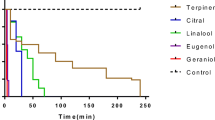Abstract
The present work evaluates the anti-Giardia activity of phenolic-rich essential oils obtained from Thymbra capitata, Origanum virens, Thymus zygis subsp. sylvestris chemotype thymol, and Lippia graveolens aromatic plants. The effects were evaluated on parasite growth, cell viability adherence, and morphology. The tested essential oils inhibited the growth of Giardia lamblia. T. capitata essential oil is the most active followed by O. virens, T. zygis subsp. sylvestris, and L. graveolens oils. The tested essential oils at IC50 (71–257) μg/ml inhibited parasite adherence (p < 0.001) since the first hour of incubation and were able to kill almost 50% of the parasites population in a time-dependent manner. The main ultrastructural alterations promoted by essential oils were deformations in typical trophozoite appearance, often roundly shape, irregular dorsal and ventral surface, presence of membrane blebs, electrodense precipitates in cytoplasm and nuclei, and internalization of flagella and ventral disc. Our data suggest that essential oils induced cell death probably by processes associated to the loss of osmoregulation caused by plasmatic membrane alterations. Experiments revealed that the essential oils did not present cytotoxic effects in mammalian cells. In conclusion, T. capitata, O. virens, T. zygis subsp. sylvestris chemotype thymol, and L. graveolens essential oils have antigiardial activity in vitro and seem to have potential for the treatment of the parasitic disease caused by the protozoan G. lamblia.






Similar content being viewed by others
References
Abodeely M, DuBois KN, Hehl A et al (2009) A contiguous compartment functions as endoplasmic reticulum and endosome/lysosome in Giardia lamblia. Eukaryot Cell 8:1665–1676
Abonyi A (1995) Examination of nonflagellate and flagellate round forms of Trichomonas vaginalis by transmission electron microscopy. Appl Parasitol 36:303–310
Adam RD (2001) Biology of Giardia lamblia. Clin Microbiol Rev 14:447–475
Adams RP (1995) Identification of essential oils components by gas chromatography/mass spectroscopy. Allured Publishing Corporation, Carol Stream
Barbosa E, Calzada F, Campos R (2007) In vivo antigiardial activity of three flavonoids isolated of some medicinal plants used in Mexican traditional medicine for the treatment of diarrhea. J Ethnopharmacol 109:552–554
Burt S (2004) Essential oils: their antibacterial properties and potential applications in foods—a review. Int J Food Microbiol 94:223–253
Busatti HG, Vieira AE, Viana JC et al (2007) Effect of metronidazole analogues on Giardia lamblia cultures. Parasitol Res 102:145–149
Calzada F, Yepez-Mulia L, Aguilar A (2006) In vitro susceptibility of Entamoeba histolytica and Giardia lamblia to plants used in Mexican traditional medicine for the treatment of gastrointestinal disorders. J Ethnopharmacol 108:367–370
Council of Europe (1997) European Pharmacopoeia. Europe Co., Strasbourg
Cristani M, D'Arrigo M, Mandalari G et al (2007) Interaction of four monoterpenes contained in essential oils with model membranes: implications for their antibacterial activity. J Agric Food Chem 55:6300–6308
Custodio JB, Moreno AJ, Wallace KB (1998) Tamoxifen inhibits induction of the mitochondrial permeability transition by Ca2+ and inorganic phosphate. Toxicol Appl Pharmacol 152:10–17
de Almeida I, Alviano DS, Vieira DP et al (2007) Antigiardial activity of Ocimum basilicum essential oil. Parasitol Res 101:443–452
Denizot F, Lang R (1986) Rapid colorimetric assay for cell growth and survival. Modifications to the tetrazolium dye procedure giving improved sensitivity and reliability. J Immunol Methods 89:271–277
Dorman HJ, Deans SG (2000) Antimicrobial agents from plants: antibacterial activity of plant volatile oils. J Appl Microbiol 88:308–316
Eckmann L (2003) Mucosal defences against Giardia. Parasite Immunol 25:259–270
Edinger AL, Thompson CB (2004) Death by design: apoptosis, necrosis and autophagy. Curr Opin Cell Biol 16:663–669
Edris AE (2007) Pharmaceutical and therapeutic potentials of essential oils and their individual volatile constituents: a review. Phytother Res 21:308–323
Elmendorf HG, Dawson SC, McCaffery JM (2003) The cytoskeleton of Giardia lamblia. Int J Parasitol 33:3–28
Faleiro L, Miguel G, Gomes S et al (2005) Antibacterial and antioxidant activities of essential oils isolated from Thymbra capitata L. (Cav.) and Origanum vulgare L. J Agric Food Chem 53:8162–8168
Flanagan PA (1992) Giardia—diagnosis, clinical course and epidemiology. A review. Epidemiol Infect 109:1–22
Fraser D, Bilenko N, Deckelbaum RJ et al (2000) Giardia lamblia carriage in Israeli Bedouin infants: risk factors and consequences. Clin Infect Dis 30:419–424
Gadelha AP, Vidal F, Castro TM et al (2005) Susceptibility of Giardia lamblia to Hovenia dulcis extracts. Parasitol Res 97:399–407
Gardner TB, Hill DR (2001) Treatment of giardiasis. Clin Microbiol Rev 14:114–128
Gillin FD, Reiner DS (1982) Attachment of the flagellate Giardia lamblia: role of reducing agents, serum, temperature, and ionic composition. Mol Cell Biol 2:369–377
Gonçalves MJ, Vicente AM, Cavaleiro C et al (2007) Composition and antifungal activity of the essential oil of Mentha cervina from Portugal. Nat Prod Res 21:867–871
Hansen WR, Tulyathan O, Dawson SC et al (2006) Giardia lamblia attachment force is insensitive to surface treatments. Eukaryot Cell 5:781–783
Harris JC, Plummer S, Turner MP et al (2000) The microaerophilic flagellate Giardia intestinalis: Allium sativum (garlic) is an effective antigiardial. Microbiology 146:3119–3127
Hill DR, Pohl R, Pearson RD (1986) Giardia lamblia: a culture method for determining parasite viability. Am J Trop Med Hyg 35:1129–1133
Holberton DV (1973) Fine structure of the ventral disk apparatus and the mechanism of attachment in the flagellate Giardia muris. J Cell Sci 13:11–41
Holberton DV (1974) Attachment of Giardia—a hydrodynamic model based on flagellar activity. J Exp Biol 60:207–221
Joulain D, König W (1998) The atlas of spectral data of sesquiterpene hydrocarbons. E. B., Hamburg
Keister DB (1983) Axenic culture of Giardia lamblia in TYI-S-33 medium supplemented with bile. Trans R Soc Trop Med Hyg 77:487–488
Lanfredi-Rangel A, Attias M, de Carvalho TM et al (1998) The peripheral vesicles of trophozoites of the primitive protozoan Giardia lamblia may correspond to early and late endosomes and to lysosomes. Struct Biol 123:225–235
Machado M, Sousa MC, Salgueiro L et al (2010) Effects of essential oils on the growth of Giardia lamblia trophozoites. Nat Prod Commun 5:137–141
Moon T, Wilkinson JM, Cavanagh HM (2006) Antiparasitic activity of two Lavandula essential oils against Giardia duodenalis, Trichomonas vaginalis and Hexamita inflata. Parasitol Res 99:722–728
Niven GW, Miles CA, Mackey BM (1999) The effects of hydrostatic pressure on ribosome conformation in Escherichia coli: and in vivo study using differential scanning calorimetry. Microbiology 145:419–425
Park JH, Schofield PJ, Edwards MR (1997) Giardia intestinalis: volume recovery in response to cell swelling. Exp Parasitol 86:19–28
Perez-Arriaga L, Mendoza-Magana ML, Cortes-Zarate R et al (2006) Cytotoxic effect of curcumin on Giardia lamblia trophozoites. Acta Trop 98:152–161
Ponce-Macotela M, Rufino-Gonzalez Y, Gonzalez-Maciel A et al (2006) Oregano (Lippia spp.) kills Giardia intestinalis trophozoites in vitro: antigiardiasic activity and ultrastructural damage. Parasitol Res 98:557–560
Santoro GF, das Gracas Cardoso M et al (2007) Effect of oregano (Origanum vulgare L.) and thyme (Thymus vulgaris L.) essential oils on Trypanosoma cruzi (Protozoa: Kinetoplastida) growth and ultrastructure. Parasitol Res 100:783–790
Sawangjaroen N, Subhadhirasakul S, Phongpaichit S et al (2005) The in vitro anti-giardial activity of extracts from plants that are used for self-medication by AIDS patients in southern Thailand. Parasitol Res 95:17–21
Silva MT, Appelberg R, Silva MN et al (1987) In vivo killing and degradation of Mycobacterium aurum within mouse peritoneal macrophages. Infect Immun 55:2006–2016
Sousa MC, Poiares-Da-Silva J (1999) A new method for assessing metronidazole susceptibility of Giardia lamblia trophozoites. Antimicrob Agents Chemother 43:2939–2942
Sousa MC, Goncalves CA, Bairos VA et al (2001) Adherence of Giardia lamblia trophozoites to Int-407 human intestinal cells. Clin Diagn Lab Immunol 8:258–265
Thompson RC (2000) Giardiasis as a re-emerging infectious disease and its zoonotic potential. Int J Parasitol 30:1259–1267
Upcroft P, Upcroft JA (2001) Drug targets and mechanisms of resistance in the anaerobic protozoa. Clin Microbiol Rev 14:150–164
Vidal F, Vidal JC, Gadelha AP et al (2007) Giardia lamblia: the effects of extracts and fractions from Mentha x piperita Lin. (Lamiaceae) on trophozoites. Exp Parasitol 115:25–31
Acknowledgments
Authors are grateful to Prof. Jorge Paiva for help in plant taxonomic.
Funding
This work was supported by “Programa Operacional Ciência e Inovacão 2010 (POCI)/FEDER” da Fundação para a Ciência e Tecnologia.
Transparency declarations
None to declare.
Author information
Authors and Affiliations
Corresponding author
Rights and permissions
About this article
Cite this article
Machado, M., Dinis, A.M., Salgueiro, L. et al. Anti-Giardia activity of phenolic-rich essential oils: effects of Thymbra capitata, Origanum virens, Thymus zygis subsp. sylvestris, and Lippia graveolens on trophozoites growth, viability, adherence, and ultrastructure. Parasitol Res 106, 1205–1215 (2010). https://doi.org/10.1007/s00436-010-1800-7
Received:
Accepted:
Published:
Issue Date:
DOI: https://doi.org/10.1007/s00436-010-1800-7




